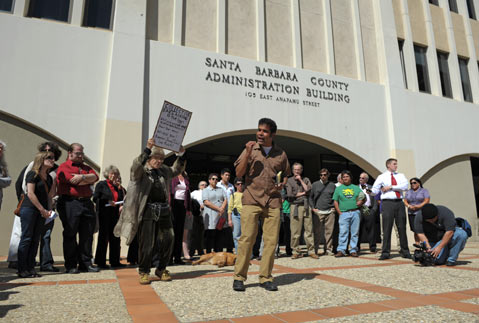Public Employee Rope-A-Dope
Democrats and Union Leaders Say They Ain't Fat Cats

After taking an anti-union jab from conservatives a few weeks back, local Democrats and union leaders responded with a few punches of their own Monday, going on the offensive in support of public employee unions.
A press conference and vigil Monday were the “start of a campaign to set the record straight,” said local Democratic Party chair Daraka Larimore-Hall to a group where, just three weeks earlier, a vastly different, largely anti-union message was being cast. Then, former supervisors Brooks Firestone and Mike Stoker, along with others from the Santa Barbara County Taxpayers Association, encouraged union leaders to sit back down at the negotiating table and forgo wage increases the unions had coming.
There was a tinge of irony as Firestone went on a pointed attack against unions’ large campaign contributions to his successor Doreen Farr’s election campaign: Many of the pay increases for union members were agreed upon not only during Firestone’s time on the board but also when he was on the majority and not when Farr was in office.
Those were, of course, also better fiscal times, before the bust of the housing bubble and the downturn in the economy. Some of the pay increases, which were deferred for a time, are now coming to fruition, with 6- to 14- percent wage increases for county employees implemented in recent months, or soon set to go into effect. Additionally, large losses in pension investments mean the retirement board has had to make adjustments, leading to the county owing an extra $20 million in pension contributions next fiscal year, on top of what it was already paying into the fund.
This all adds up to a roughly $70-million deficit for the county. It’s at a time when the private sector has been slashing jobs and benefits for several years; at a time when residents are furious over the betrayal of trust by public employees in the City of Bell; and at a time when a battle is being waged in several states across the country, most notably and symbolically in Wisconsin, where tens of thousands of protesters have been shadowing the capitol building to fight anti-union legislation.
In a way, Santa Barbara has been at the epicenter of California’s own fight, when Lanny Ebenstein, a conservative activist and frequenter of the News-Press editorial page, announced he would be attempting to get a measure on the 2012 ballot that would end a union’s ability to collectively bargain on behalf of county employees.
And it certainly is representative of many of the problems facing cities and counties throughout California. Declining budgets and increasing salaries, benefits, and pensions here in Santa Barbara have started a firestorm of activity, ranging from public outcries to a Grand Jury survey of county governmental agencies and a planned public debate on public employee unions.
Monday morning, the Santa Barbara Grand Jury released its first report of 2011, a survey of executive compensation of all 72 governmental agencies within the county. The Grand Jury, in the survey’s introduction, said that while the information is public, few citizens knew much about the salaries. Since the Bell scandal, many agencies have been making salary and benefit information more accessible to the public, like the City of Santa Barbara, which posted on its Web site a link to information on salary and benefits. And the County Auditor-Controller unveiled this week a comprehensive, sortable data sheet that can be manipulated to produce most any salary figure a user might be interested in.
For instance, a level-one administrative office professional in the Public Health Department has a base salary of $36,435. But the total cost to the county for that employee when additional pay and benefits are factored in is closer to $63,000. A sheriff’s deputy makes a base salary of $81,570, but after everything else is factored in, it can be a $144,000 to $186,000 annual cost to the county. An ADMHS psychiatrist whose base salary is $202,939 a year can cost the county roughly $287,000 to $307,000 a year.
The Santa Barbara Chamber of Commerce will keep the discussion going, with a debate on the need for public employee unions, featuring Ebenstein, Dr. Nelson Lichtenstein from UCSB, and leaders of three local union chapters.
The press conference Monday portrayed public employees as hard-working people who don’t have cushy salaries or benefits, unfairly being blamed for the state and local fiscal issues. They rolled out the carpet for various speakers representing various unions, one by one coming forward to show that they were not fat cats feeding from the public trough, but rather ordinary people making ordinary salaries, like Deedrea Edgar, a deputy public defender. She said that while many in her office could be working in a private law firm making hundreds of thousands of dollars, their “heart drives them to serve the public. I make a sacrifice,” Edgar explained. “I’m not wealthier for being a public employee.”



